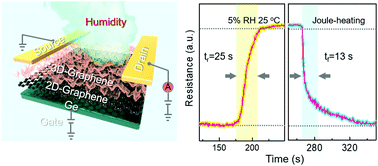Role of interfacial 2D graphene in high performance 3D graphene/germanium Schottky junction humidity sensors†
Abstract
Three-dimensional graphene (3D-Gr) is an attractive nominee for humidity sensing due to its considerable specific surface area and excellent thermal properties. Nevertheless, in the current method of preparing 3D-Gr, amorphous carbon layers are added as an interfacial layer, which will reduce the thermal/electrical property of 3D-Gr-based devices. Herein, by employing two-dimensional graphene (2D-Gr) as an interfacial layer in plasma-assisted chemical vapor deposition (PACVD), in situ synthesis of 3D-Gr on a Ge substrate can improve its performance when used as a humidity sensor. The resulting 3D/2D-Gr/Ge hybrid architecture has excellent Schottky junction-based humidity sensing characteristics with the fastest response rate and recovery time at room temperature because of its enhanced thermal/electrical conductivity without multiple post-transfer processing steps being required during device fabrication. Furthermore, Joule heating dismisses physically adsorbed vapour molecules from the 3D/2D-Gr hybrid architecture, thus realizing the completely reversible operation thereof. The mechanism of humidity detection was explored by experiments and confirmed by scanning Kelvin probe microscopy (SKPM) and finite-difference time-domain (FDTD) simulation. The rational design of hybrid architecture with 2D-Gr has proven to be advantageous for developing the humidity sensing performances of the device.



 Please wait while we load your content...
Please wait while we load your content...